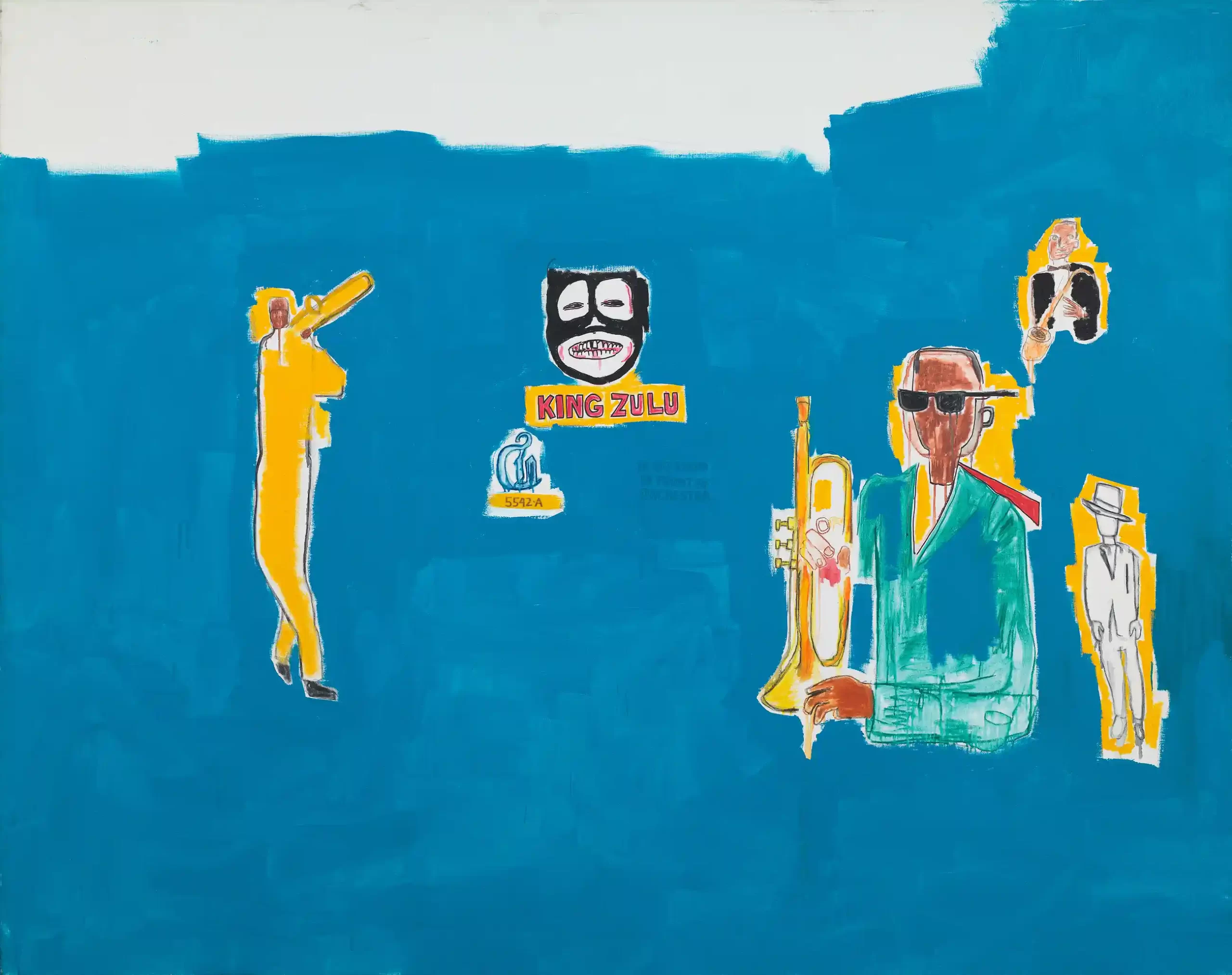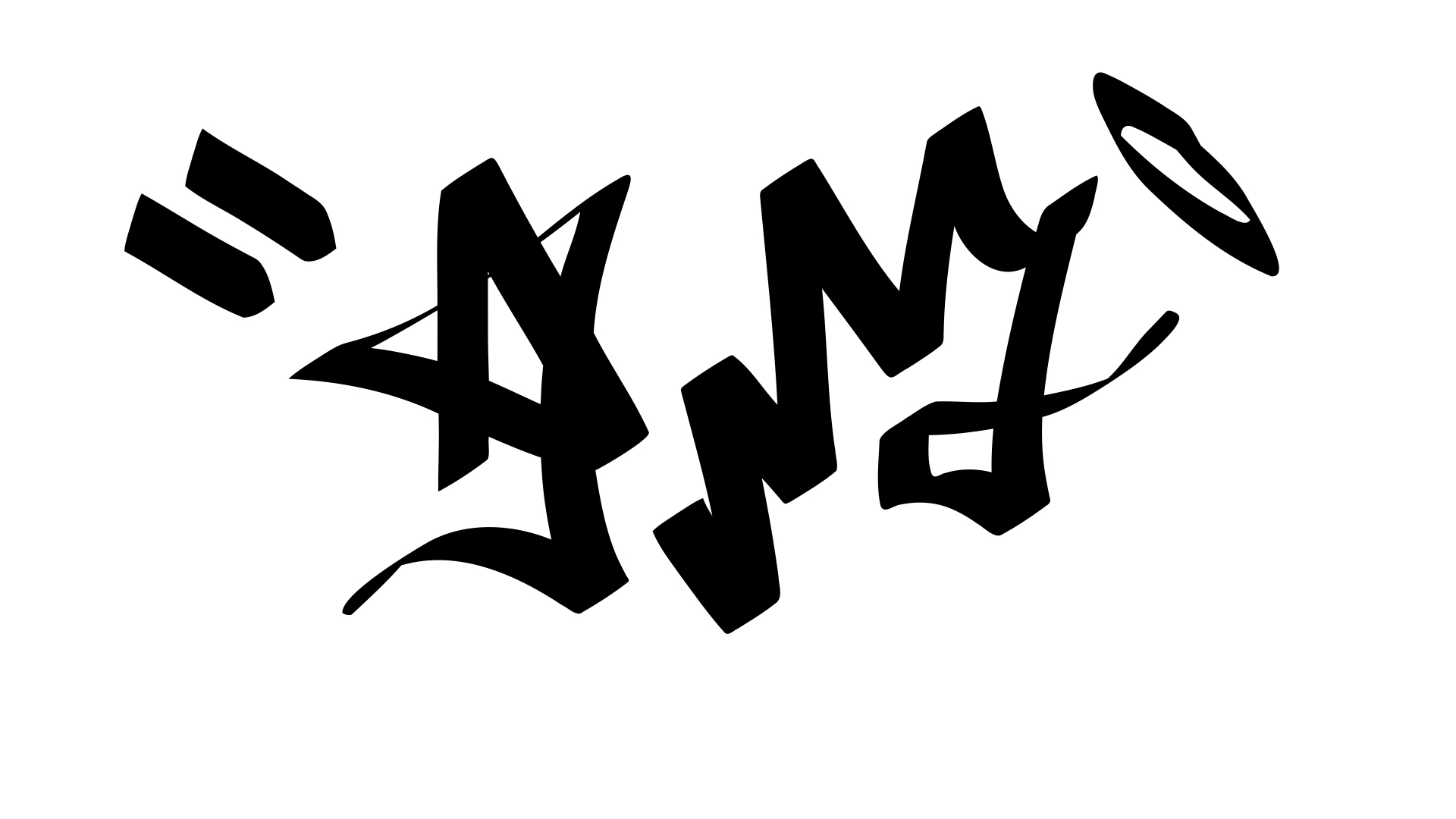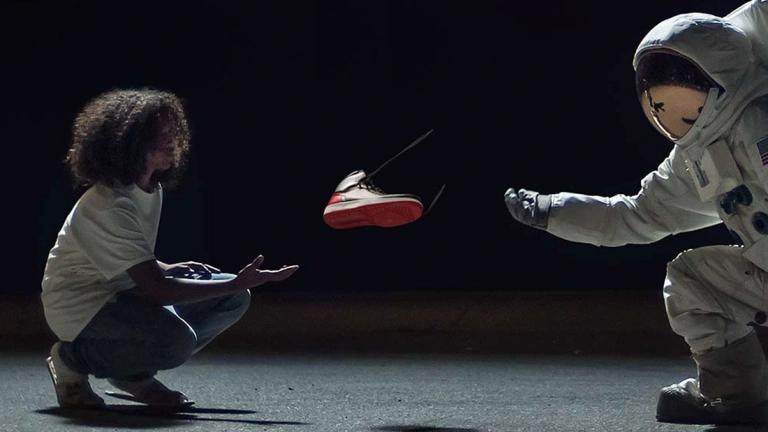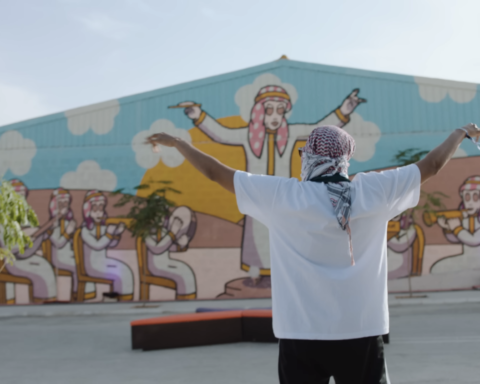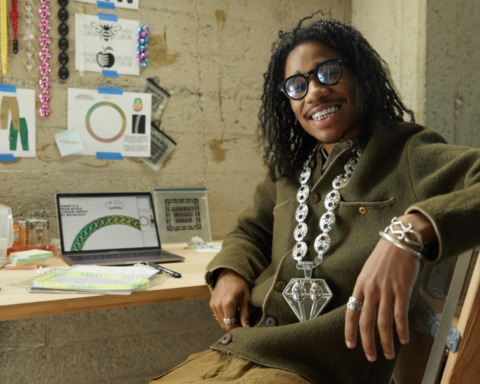The loudness of the paintings greets you as you go through the museum. Anybody Speaking Words, a 1982 piece, features a performer’s body vibrating with lines, squiggles, and curlicues while singing the word “OPERA, OPERA, OPERA” with a tonsil-filled lip.
King Zulu [seen above] is a field of vibrant sky-blue filled with the likenesses of iconic jazz musicians, including Charlie Parker on saxophone and Louis Armstrong holding his trumpet—a band of all-time greats. Armstrong and Parker can be found nearby once again in the 1984 artwork “Plastic Sax.” One explosive word, “KABOOM,” is scrawled in the corner of the frame, surrounded by grotesque clouds.
In the 34 years since Jean-Michel Basquiat his away at the age of 27, there have been almost as many attempts to dissect his intricate, nuanced body of work as there have been exhibitions and news pieces about him. He received praise for introducing the chaotic, scrappy energy of street art to the larger art community in his own time (too scrappy for many museums, who turned down offers to acquire his paintings and must now be kicking themselves). He has been described as an Afrofuturist, an arch-postmodernist, and even a revived Beat poet. His complicated friendship with Andy Warhol has drawn the interest of others to the point where the topic has inspired a play called The Collaboration that will soon be made into a movie.

Basquiat, who confronted police brutality and America’s poisonous relationship with race, has only recently come to be recognized as one of the most politicized African American artists of his generation as the Black Lives Matter movement has grown and grown.
“To Basquiat, music was much more than a soundtrack,” she says. “It was something he absorbed and communicated with.”
The link has previously been established. While a trio of short films, Time Decorated, last year explored the artist’s fascination with rap, no-wave, and bebop, the Barbican’s 2018 retrospective devoted significant space to Basquiat’s emergence from the nightlife scene of the late 1970s and early 1980s New York, noisy with early hip-hop and post-punk. The Montreal exhibition, however, is the most thoroughgoing attempt to date to demonstrate how deeply music permeated not just Basquiat’s soul but also nearly everything he did. It includes more than 100 paintings, notebooks, sound clips, and multimedia snippets, many of which were plucked from private collections. 
Basquiat recalls being surrounded by music as a young child while growing up in Brooklyn, according to his younger sister Jeanine Heriveaux, who currently shares management of his estate with her sister Lisane. “It was always on, particularly at weekends. It was our father [Gerard]’s downtime: on Sunday mornings he’d be up early, and you’d hear this progression of music, starting with classical, then moving on to jazz – everyone from Ella Fitzgerald and Miles Davis to Charlie Parker to Louis Armstrong. He loved jazz especially, and that rubbed off on Jean-Michel.”
As Gerard recalled in a conversation before passing away in 2013, “for him, the ear would be listening to music and the hand would be making art.”
Contemporary writers characterize the adult Basquiat as functioning similarly. When you walked into his studio, the TV would be on, music would be playing, and a drum machine would be pumping away as he put together collages or experimented with oil sticks. The incantatory, ever-building crescendo of Ravel’s Bolero made it a favorite at times, but more frequently, Basquiat listened to the bebop he originally heard at his father’s knee. At the time of his passing, the artist had 3,000 recordings in his collection, which included artists like Donna Summer, Bach, Jimi Hendrix, and David Byrne. His varied preferences can be seen in the Spotify playlists that Jeanine and Lisane have put together for a related exhibition in New York…
Did Jeanine and her elder brother swap listening tips? “Oh, for sure,” she laughs. “I was young at the time, maybe 13 or 14, but I remember one time he introduced me to [hip-hop artist] Jimmy Spicer. He’d just been DJing it at a party.”
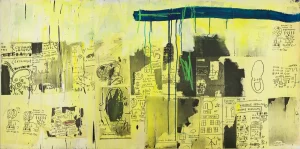
Basquiat’s passionate commitment to the downtown Manhattan underground scene, which was centered on the Mudd Club in Tribeca and CBGB in the East Village, led to the emergence of further musical influences. He socialized with numerous musicians there, including Fab Five Freddy, Debbie Harry, John Lurie, and Laurie Anderson (not to mention, a few years later, his on-off romance with an emerging dancer and singer called Madonna).
In 1979, Basquiat and filmmaker Michael Holman co-founded the “noise band” Gray, which quickly gained notoriety for its abrasive, atonal performances. According to tradition, the band was named after the medical encyclopedia Gray’s Anatomy, which is frequently referred to in Basquiat’s artwork. The musician played clarinet and percussion with vigor. One of his bandmates remarked, “He never played one recognizable melody. Possibly for the best, no recordings of Gray with Basquiat exist.
Instead, Basquiat employed these ideas in the boisterous canvases he was starting to create throughout the early 1980s, organizing them like musical arrangements, as the Montreal exhibition makes evident. His 1984 collage Toxic, a frenetic collection of scrawled images and comical found phrases (“hare conditioned,” “soup to nuts,” “eggs don’t bounce”), reads almost like visual hip-hop. It was put together using copies of Basquiat’s drawings that he had made himself, which he had then layered together like a producer could layer a track.
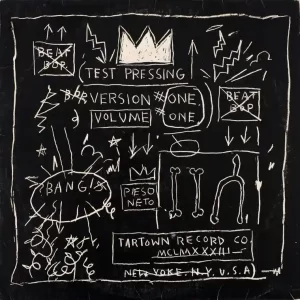
“He was sampling his work,” says Desmarais. “He’s Xeroxing pre-existing drawings and creating these radical juxtapositions, much in the way that hip-hop artists would sample other sounds to create new ones.”
Basquiat did occasionally work actively in the production process. For example, the year prior, he contributed to the production of Rammellzee and K-song Rob’s Beat Bop and designed its ominous black-and-white cover art.
But more than any other genre, jazz, especially bebop, served as the artist’s inspiration and source of creative fuel again and time again. In some ways, co-curator Vincent Bessières argues, it is paradoxical: this endlessly experimental young artist thought that music composed 40 years earlier was the stuff that spoke to him while residing in New York City during one of its most fruitful musical eras. More than 30 significant works make clear allusions to jazz, while many notebooks and sketches are filled with cryptic allusions to the music.
“There’s footage of him dancing in his studio to Ellington,” Bessières says. “And if you see pictures of him DJing, you look carefully and notice that the LPs around him are Charlie Parker, Ben Webster, Lester Young. That’s what he was listening to.”
From Charles, the First (1982), Basquiat’s breakout work, to Kokosolo (1983), which is displayed prominently in Montreal, the ghostly image of Parker can be seen in several of his paintings. The top of the acid-yellow canvas, which is covered in photocopies referencing anything from the Bible to advertisements, is swooshed exultantly in black acrylic paint. The piece pays homage to one of Parker’s most astonishing records, Koko (1945). Basquiat tried to emulate Parker’s physical virtuosity and the way he matched formal rigor with joyful spontaneity in this work.
“It reads like a sheet of music,” Bessières points out. “It’s full of quotes and riffs, these motifs he used elsewhere and kept returning to, like a jazz musician drawing on standards.”
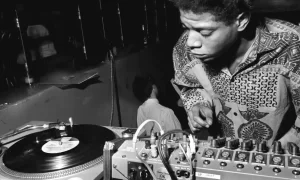
Basquiat’s pantheon included musicians like Parker and Billie Holiday, contends Heriveaux. “He regarded them as royalty, these specifically black heroes. It was important for him to honor them.”
Even so, as the paintings emphasize, Basquiat was acutely aware of the price many of his forebears paid – notably Parker, whose life was beset by sorrows and poverty, and who died at 34 after a struggle with heroin addiction. Heroin also became Basquiat’s drug of choice, and in the end, it killed him. In the left-hand corner of Charles the First, Basquiat placed the text “MOST YOUNG KINGS GET THEIR HEAD CUT OFF.”
“I think there’s some kind of personal identification with Parker,” says Bessières. “He’s like Basquiat’s double, in a way.”
In the last room of the exhibition hang two of his very last works, made in 1988 after the sudden death of Warhol and when Basquiat himself was slowly being enveloped by addiction. The title of the series, Eroica (Heroic), pays tribute to Beethoven’s Symphony No 3, whose second movement is a doleful funeral protest; the music itself plays on a soundtrack in the gallery.

In Eroica I, Basquiat obsessively inscribes text that looks like it might be scrawled on the walls of a jail cell – “MAN DIES MAN DIES MAN DIES” – next to blood-red holes that could be bullet wounds. Nearby is the phrase “FIXINTODIEBLUES”, a reference to a song sung by the Delta blues artist Bukka White. That song echoes around the gallery, too. A few final bars, then silence.
